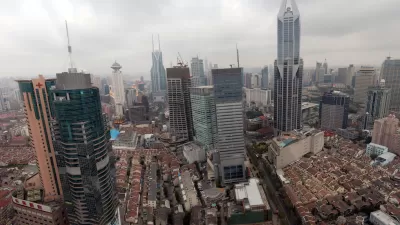I've been spending a lot of time over the past couple of years examining the planning literature on sustainable development. Sustainable development, as a concept, remains vague. For those interested, take a look at my recent article in the journal Property Management.
I've been spending a lot of time over the past couple of years examining the planning literature on sustainable development. Sustainable development, as a concept, remains vague. For those interested, take a look at my recent article in the journal Property Management.
But, does the practice of sustainable development provides real guidance for how we design communities and live? For example, is slowing down the rate of land development really a move toward sustainability? What's the difference if we run out of land in 300 years versus 500 years? At some point, real sustainability means that land must be recycled efficiently and effectively to accomodate future increases in population. Technology will be critical to achieving this, but its role is not necessarily embraced in the sustainability movement.
A case in point is agriculture and food production. The amount of farmland has been falling for decades. Headlines tend to blame sprawl. But, more farmland has been left fallow because of changes in technology than because urban land places a higher economic value on it. (For an analysis of this trend, see my policy brief here.) Improvements in technology have dramatically increased agricultural productivity, reducing the need for land and people to grow food. In short, the "foot print" for agriculture has become smaller. Technology, as a result, has changed very nature of what can be considered sustainable in food production--we're using less land (and other resources) in the U.S. and generating less demand for these resouces because of increases in productivity.
Unfortunately, the sustainable development literature, particularly that written in the environmental tradition, seems to focus on agricultural and food self-sufficiency as the goal of sustainable development policy. yet, self sufficiency, by its nature, implies a bigger environmental footprint and lower oveall productivity. Pursuing a food policy that focuses primarily on "home grown" food products may actually work against sustainability, both in terms of making the environmental footprint for agriculture larger as well as compromising our ability to sustain larger populations.

Maui's Vacation Rental Debate Turns Ugly
Verbal attacks, misinformation campaigns and fistfights plague a high-stakes debate to convert thousands of vacation rentals into long-term housing.

Planetizen Federal Action Tracker
A weekly monitor of how Trump’s orders and actions are impacting planners and planning in America.

In Urban Planning, AI Prompting Could be the New Design Thinking
Creativity has long been key to great urban design. What if we see AI as our new creative partner?

King County Supportive Housing Program Offers Hope for Unhoused Residents
The county is taking a ‘Housing First’ approach that prioritizes getting people into housing, then offering wraparound supportive services.

Researchers Use AI to Get Clearer Picture of US Housing
Analysts are using artificial intelligence to supercharge their research by allowing them to comb through data faster. Though these AI tools can be error prone, they save time and housing researchers are optimistic about the future.

Making Shared Micromobility More Inclusive
Cities and shared mobility system operators can do more to include people with disabilities in planning and operations, per a new report.
Urban Design for Planners 1: Software Tools
This six-course series explores essential urban design concepts using open source software and equips planners with the tools they need to participate fully in the urban design process.
Planning for Universal Design
Learn the tools for implementing Universal Design in planning regulations.
planning NEXT
Appalachian Highlands Housing Partners
Mpact (founded as Rail~Volution)
City of Camden Redevelopment Agency
City of Astoria
City of Portland
City of Laramie




























